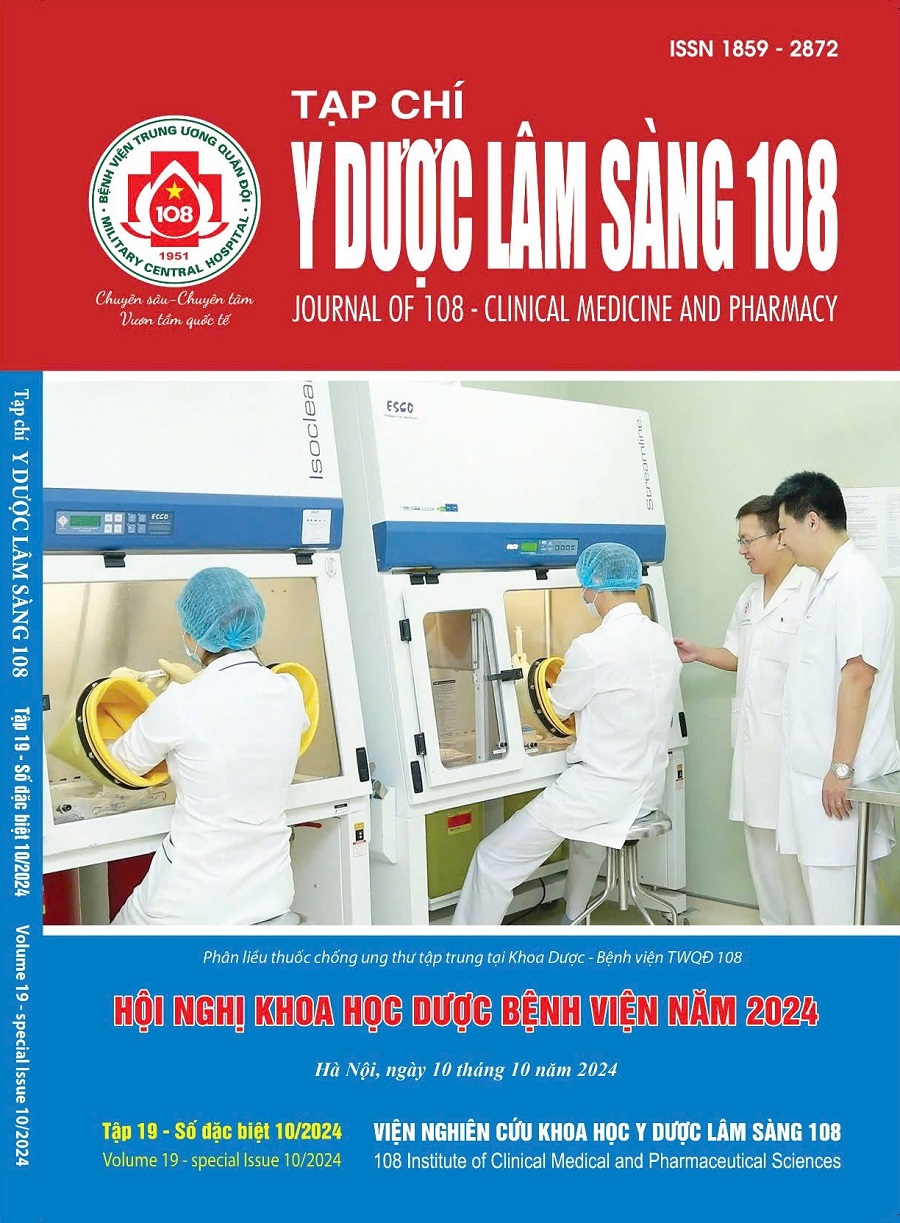Analysis of the pattern of chemotherapy use in breast cancer patients at K hospital
Main Article Content
Keywords
Abstract
Objective: To analyze chemotherapy indication, dosage, and administration among breast cancer patients. Subject and method: A cross-sectional study was conducted on medical records among breast cancer patients admitted to Internal Medicine Departments Five and Six at Vietnam National Cancer Hospital from 01/01/2024 to 31/03/2024 for chemotherapy. Result: The study included 220 patients with an average age of 51.0 ± 10.6, mainly in stages II and III (73.2%), and with HR+ /HER2- (67.7%). 62.8% of patients were prescribed adjuvant chemotherapy. The most popular regimens were the combination of taxan and anthracycline (61.8%) or taxan without anthracycline (34.1%). The proportions of chemicals used at doses greater than or equal to 90% of the recommended standard doses in the neoadjuvant/adjuvant and metastatic/recurrent groups were 87.4% and 39.3%, respectively. Inappropriate routes of administration accounted for 25.9% of the chemical uses, attributed to doxorubicin and epirubicin. 100% of chemical uses were dissolved in suitable solvents and solvent volumes as guideline recommendations. Conclusion: Taxan-containing regimens with or without anthracycline are still the most common regimens for breast cancer patients, with the majority of patients being given the recommended doses. The multidisciplinary team needs to keep coordinating to solve some unreasonable problems and optimize treatment effectiveness and safety for patients.
Article Details
References
2. Network National Comprehensive Cancer. Breast cancer v2.2024.
3. Bộ Y Tế (2020) Hướng dẫn chẩn đoán và điều trị ung thư vú. Quyết định số 3128/QĐ_BYT ngày 17 tháng 07 năm 2020 về việc ban hành tài liệu chuyên môn.
4. National Cancer Control Programme. Breast SACT Regimens. Accessed July 10, 2024. https://www.hse.ie/eng/services/list/5/cancer/profinfo/chemoprotocols/breast/".
5. New South Wale Goverment eviQ. Accessed July 10, 2024. https://www.eviq.org.au/.
6. American Society Cancer. Breast Cancer Facts & Figures. Accessed July 10, 2024. https://www.cancer.org/research/cancer-facts-statistics/breast-cancer-facts-figures.html.
7. Trần Thị Thu Phương (2022) Phân tích chi phí liên quan đến điều trị ung thư vú HER2 dương tính tại Bệnh viện K cơ sở Tân Triều, Hà Nội. Đại học Dược Hà Nội.
8. Nguyễn Thị Huê (2019) Phân tích tình hình sử dụng phác đồ hóa trị trên bệnh nhân ung thư vú điều trị tại Bệnh viện Ung bướu tỉnh Thanh Hóa. Đại học Dược Hà Nội.
9. de Ruijter TC, Veeck J, de Hoon JP, van Engeland M, Tjan-Heijnen VC (2011) Characteristics of triple-negative breast cancer. J Cancer Res Clin Oncol 137(2):183-192. doi:10.1007/s00432-010-0957-x.
10. Loibl S, Gianni L (2017) HER2-positive breast cancer. The Lancet 387(10087): 2415-2429.
11. Lyman GH (2009) Impact of chemotherapy dose intensity on cancer patient outcomes. J Natl Compr Canc Netw 7(1): 99-108. doi:10.6004/jnccn.2009.0009.
12. Limited Datapharm Communications. electronic medicines compendium. Accessed July 10, 2024. https://www.medicines.org.uk/emc.
13. Ghiami H, Omidkhoda N, Seddigh-Shamsi M, Rahimi H, Arasteh O (2024) Comparison of bolus administration and short-term infusion versus long-term infusion of doxorubicin in terms of cardiotoxicity and efficacy. Naunyn Schmiedebergs Arch Pharmacol 397(6): 3771-3780. doi:10.1007/s00210-023-02886-8.
 ISSN: 1859 - 2872
ISSN: 1859 - 2872
